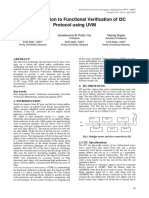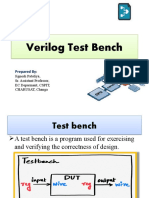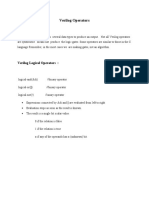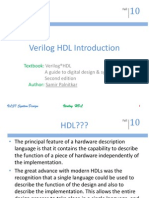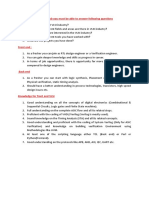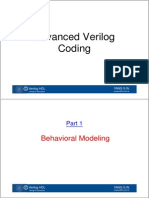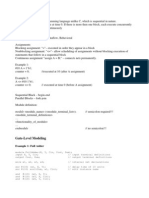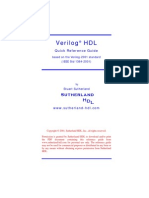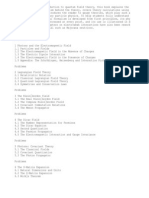Verilog HDL Introduction
1 R V College of Engineering 24/1/2014
Verilog HDL - History
Invented by Phil Moorby & Prabhu Goel at Gateway Design
Automation Systems in 1983/84.
Later , Cadence took full proprietary in 1990.
In 1995, Cadence published Verilog for public domain under OVI
(Open Verilog International).
Verilog-95 – IEEE Standard 1364-1995.
Verilog 2001 – IEEE Standard 1364-2001.
Verilog 2005 – IEEE Standard 1364-2005.
2 SystemVerilog – Extended from Verilog and C++.
R V College of Engineering 24/1/2014
Levels of Abstraction
Highest Level
Verilog supports a design at 4 of Abstraction
different levels of abstraction.
Behavioral Level
Dataflow Level
Gate Level
Switch level
Lowest Level
of Abstraction
Register Transfer Level :
A combination of Behavioral and Data flow.
3 R V College of Engineering 24/1/2014
Levels of Abstraction (Cont..)
Behavioral Level :- Used to model the behavior of a design
without describing its actual hardware structure.
Data Flow Level :- Describes the flow of data between
registers and how a design processes that data.
Gate Level :- Describes the logic gates and the connections
between logic gates in a design.
Switch Level :- Describes the transistors and storage nodes in a
device and the connections between :-describes them
4 R V College of Engineering 24/1/2014
Design Methodologies
There are 2 types of design methodologies:
Top-down design methodology, and
Bottom-up design methodology.
In a top-down design methodology, we define the top-level block
and identify the sub-blocks necessary to build the top-level block.
In a bottom-up design methodology, we first identify the building
blocks that are available to us. We build bigger cells, using these
building blocks.
5 R V College of Engineering 24/1/2014
Design Methodologies (Cont..)
Top-Down Design Methodology
6 R V College of Engineering 24/1/2014
Design Methodologies (Cont..)
Bottom - up Design Methodology
7 R V College of Engineering 24/1/2014
Structure of module
module <mod name> (<port list>);
<declarations>; // input, output, inout
// wire, register, etc.
<statements>; // initial, begin, end, always
// dataflow statements
endmodule
8 R V College of Engineering 24/1/2014
Structure of module (Contd..)
The <module name> is an identifier that uniquely names the
module.
The <port list> is a list of input, inout and output ports which are
used to connect to other modules.
The <declares> section specifies data objects as registers,
memories and wires as wells as procedural constructs such as
functions and tasks.
The <statements> may be initial constructs, always constructs,
9 continuous assignments or instances of modules.
R V College of Engineering 24/1/2014
EXAMPLE
module half_adder (I1, I2, O1, O2);
input I1;
input I2;
output O1;
output O2;
// Blank lines are allowed
assign 01 = I1 ^ I2;
assign O2 = I1 & I2;
endmodule
10 R V College of Engineering 24/1/2014
Basic Languages Concepts
11 R V College of Engineering 24/1/2014
Lexical Conventions
•Similar to those in C
•Verilog contains stream of tokens
•Tokens can be
–Whitespace
–Comments
–Operators
–Numbers (constants)
–Strings
–Identifiers
–Keywords –are in lowercase!!!!!
12 R V College of Engineering 24/1/2014
Whitespace
•Consists of
–Blank spaces, tabs and newlines
•Whitespace is ignored in Verilog EXCEPT when it separates
tokens
•White space not ignored in strings
13 R V College of Engineering 24/1/2014
Verilog Comments
Verilog supports 2 type of comment syntaxes
Single line comment start with //, and end with newline.
Block comment, start with /*, and end with */. Block comment cannot
be nested.
14 R V College of Engineering 24/1/2014
Strings
•Enclosed in double quotes
•Sequence of characters
•Has to be contained in one single line –without a return
–i.e –cannot be on multiple lines
–“Hello world”
–“a/b”
15 R V College of Engineering 24/1/2014
Keywords
•Verilog contains keywords, which are predefined
•They are lowercase and case sensitive
16 R V College of Engineering 24/1/2014
Identifier
A letter or _ can be followed by letters, digits, $ and _
Cannot start with digit or $ sign
Max 1024 characters
First character cannot be digit or $ ($ is reserved for tasks)
reg value; //reg–keyword, value –identifier
input clk; //input –keyword, clk–identifier
17 R V College of Engineering 24/1/2014
Numbers in Verilog (i)
<size>’<radix> <value>
No
Noofof Binary
Binary
bbor
orBB Consecutive
bits Consecutivechars
chars
bits Octal
Octal
ooororOO 0-f,
0-f,x,x,zz
Decimal
Decimal
ddor
orDD
Hexadecimal
Hexadecimal hhor
orHH
8’h ax = 1010xxxx
12’habc //12 bit hexadecimal number
18 Verilog HDL Basics
Numbers in Verilog (ii)
You can insert “_” for readability
12’b 000_111_010_100
12’b 000111010100 Represent the same number
Bit extension
MS bit = 0, x or z extend this
4’b x1 = 4’b xx_x1
32’bz//32 bit high impedance number
4’b10?? = 4’b10zz
19 Verilog HDL Basics
Numbers in Verilog (iii)
If size is ommitted it
is inferred from the value or
takes the simulation specific number of bits or takes the
machine specific number of bits
’hc3// This is 32 bit
If radix is ommitted too .. decimal is assumed
15 = <size>’d 15
20 Verilog HDL Basics
Data Types
•Value/Scalar set
•Nets
•Registers
•Vectors
•Integer, Real and Time Register
•Arrays
•Strings
21 R V College of Engineering 24/1/2014
Value/scalar set
A scalar quantity is a single bit
The value of this bit can be one of
0 -logic zero (false)
1 -logic one (true)
x -unknown value
z -high-impedance value, floating gate
22 R V College of Engineering 24/1/2014
Nets
•Nets represent connections between hardware elements
•Nets are declared with keyword wire
•One-bit values by default unless declared explicitly as
vectors
•Default value is z
•Net is not a keyword
–It represents class of data type such as wire, wand, wor,
etc
23 R V College of Engineering 24/1/2014
Register
•Represent data storage elements(Variable that can hold value).
•Retain value until another value is placed onto them
reg A, C; // declaration
// assignments are always done inside a procedure
A = 1;
C = A; // C gets the logical value 1
A = 0; // C is still 1
C = 0; // C is now 0
•Values of register can be changed anytime in simulation by
assigning new value to register
•Declared using keyword reg. Unlike nets, registers do not need any
drivers
•Default value is x. outputs used in always block declared as reg.
24 R V College of Engineering 24/1/2014
Vectors
Both nets and registers can be declared as vectors
•They are declared by using a range specifierin the declaration:
wire [msb:lsb] w1;
reg[msb:lsb] r1;
•Both msb and lsb must be constant valued expressions
wire [3:0] busA;
reg [1:4] busB;
reg [1:0] busC;
Vector assignment (by position!!)
busB[1] = busA[3];
busB = busA;
busB[2] = busA[2];
busB[3] = busA[1];
busB[4] = busA[0];
25 R V College of Engineering 24/1/2014
Integer & Real Data Types
Declaration
integer i, k;
real r;
Use as registers (inside procedures)
i = 1;
r = 2.9;
k = r; // k is rounded to 3
Integers are not initialized!!
Reals are initialized to 0.0
26 Verilog HDL Basics
Time
Simulation is done wrt simulation time
Time variable declared with keyword time
System function $time is invoked to get current
time time save_time;
initial
save_time = $time; //save the current simulation time
27 R V College of Engineering 24/1/2014
Arrays
Arrays are allowed for reg, integer, time, real,
realtime and vectorregister data types
Accessed using
<array_name>[<subscript>]
Do not confuse arrays with net or register vectors
Vector is single element that is n-bit wide
Arrays are multiple elements that are 1-bit or n-bit
wide
28 R V College of Engineering 24/1/2014
wire [7:0] x; // a vector
wire x [7:0]; // an array
wire [7:0] x [7:0]; // an array of vectors
wire x[7:0][7:0]; // a two dimensional array
integer count[0:7]; //array of 8 count variables
count[5] = 0; //reset 6th element of array of count
Declare memory : Mem1k*4
Reg[3:0]mem1k[0:1023]
4 bits
0
.
.
1023
29 R V College of Engineering 24/1/2014
Parameters
Parameters represent global constants. They are
declared with a predefined word parameter.
Parameters are constants typically used to specify the
width of variables and time delays.
module (x,y,z);
parameter N=3;
input [N:0] x;
30 R V College of Engineering 24/1/2014
Operators
31 R V College of Engineering 24/1/2014
Logical Operators
&& logical AND
|| logical OR
! logical NOT
Operands evaluated to ONE bit value: 0, 1 or x
Result is ONE bit value: 0, 1 or x
A = 1; A && B 1 && 0 0
B = 0; A || !B 1 || 1 1
C = x; C || B x || 0 x
32 R V College of Engineering 24/1/2014
Logical Operation Example
33 R V College of Engineering 24/1/2014
Bitwise Operators
34 R V College of Engineering 24/1/2014
Reduction operators
Key symbols: &, ~&, |, ~|, ^, ~^, ^~.
The reduction operators are and, nand, or, nor, xor, xnor.
They take one operand and perform a bit-by next- bit
operation, starting with the two leftmost bits, giving a 1-bit
result.
35 R V College of Engineering 24/1/2014
Relational & Equality Operators
36 R V College of Engineering 24/1/2014
Shift operators
Key symbols:
>>: right shift
<<: left shift
The empty bits caused by shifting are filled with zeros.
a = 4’b1010;
...
d = a >> 2; // d = 0010
c = a << 1; // c = 0100
37 R V College of Engineering 24/1/2014
Conditional Operator
cond_expr ? true_expr : false_expr
A ternary operator
Acts like a 2-to-1 mux.
38 R V College of Engineering 24/1/2014
Concatenation Operator
{,}: concatenation operator
{op1, op2, ..}concatenates op1, op2, .. to single number.
39 R V College of Engineering 24/1/2014
Replication Operator
{} : replication operator
<no> { <variable/sized_number> }
<no> is an integer.
40 R V College of Engineering 24/1/2014
Arithmetic Operators (i)
+, -, *, /, %,**
Negative integers:
can be assigned negative values
different treatment depending on base specification or not
reg [15:0] regA;
integer intA;
..
intA = -12/3; // evaluates to -4
41 Verilog HDL Basics
Operators
•There are of three types
–Unary -precede the operand
a = ~b; //~ is a unary operator. b is the operand
–Binary –operators appear between two operands
a = b && c; //&& is a binary operator. b and c are
operands
–Ternary –have two separate operators that separate three
operands
a = cond_expr? true_expr: false_expr//?: -ternary
operator.
R V College of Engineering
42 24/1/2014
Operator Precedence
Use parentheses to
enforce your
priority
43 Verilog HDL Basics















